
Victoria Bay, west L. Conn; We’ve got a Problem!
Aerial view (RIGHT) covers the main productive area for S. romanzoffiana in L. Conn, Co Mayo. Coincidentally, the bottom of the former abundant Zone coincides with the 54.00°N line of Latitude. and 54.016° is the Latitude at the top of the image. Also Latitude 54.01° cutting through Massbrook Point seems particularly significant — again purely coincidental. The upper section with all the green symbols on it was counted on 31st of July. We observed (in 2021) that numbers of Spiranthes were starting to re-occur in this area following clearing of the shore and pulling scrub back to the tree-line in front of the brown bog. This is a very flat shore with a large width of up to 100m from low water level in the lake to the top of the shore. In clearing this shore, many Alder trees were pulled up by their roots leaving a wide shallow hollow to fill with rain water or rising lake level. A perfect Habitat. This has created a perfect habitat for Spiranthes with a wide area very acceptable for seed deposition around the numerous margins to the multiple small ponds. Even after months of dry conditions these ponds still remain moist or wet and Spiranthes are starting to re-colonise this shoreline very impressively. Aware of this possibility we undertook another survey of the whole area from the Massbrook Point northwards. The same survey in July produced 41 records; this one yielded 115 and, possibly, many more undetected. So we don’t have a problem, just a resourceful and adaptive plant. The ‘unique’ climate we have been experiencing in Ireland has dried up many plants, trees and crops. Fortunately, this large flat area seems to benefit from mist and cool mornings sufficient to retain enough moisture in this exposed area to allow these new seedlings to emerge and thrive; there must be many seedlings (first year germinating) here to explain the surge in numbers. Implication. South of The Point lies a similar previously fertile zone which this year produced no Spiranthes at the first search! It has been declining for many years and a total failure to occur must have a cause. We see 2 possibilities. Firstly the shoreline here is now markedly different with much stonier shoreline indicating greater exposure to onshore wave action. This reflects the large area of very shallow water north of Massbrook Point and possibly much deeper water south of the point allowing larger waves to crash on the south shore leaving pebbles and boulders and washing away the delicate shoreline that is imperative as a seedbed for water borne seeds of S. romanzoffiana. NB: A recent survey on the 26th August has found 11 new records in their old habitat between where the stream enters the lake and Massbrook Point to the north. All these new records came from exactly the zone where stronger plants were last seen at mid shore in among sturdy Alder bushes; we are sure these are the same specimens. So, the mature plants survived while the large number of new plants that were recorded 2/3 years ago failed to make a secure attachment. IT MAY BE NECESSARY TO DO AN AUTUMN SURVEY on SOUTHERN SHORE if water levels remain the same, as further mature plants behind the water’s edge may still be secure underground.




* LINKED SITE:
WildWest.ie continues the work started with LoughAllenBasin.com We have linked
to certain archived pages on that site, but WE ARE NOT UPDATING it! If you visit such
a page return here using a WildWest TAB or use the BACK BUTTON on your Browser.
Thank you!

Spiranthes search 2022:
Loughs Cullin and Conn: The Spiranthes in mind is Spiranthes
romanzoffiana, a rare but very well represented Orchid here in these
lakes in mid Summer.
NB
To ENLARGE an Image CLICK
where you see this symbol.


2022 Spiranthes romanzoffiana REPORT
This Report commences in Mid July as the plants have been a week to 10 days late in emerging. However, today (27/07/22) they have emerged widely and, in some places, enthusiastically. All Images are from that date and come from North and East L. Cullin and one site on the east side of L. Conn Why delayed? After 2 previous null surveys we felt that the low water level had exposed many of the silt/sand shores enabling them to dry out, and even exposing orchid roots to night time frost in May and June. Many well established perennial plants, shrubs and small trees (Marsh Pimpernel, Royal Fern, Lesser Water Plantain, and Yellow_eyed Grass were unaffected by the dry conditions but the larger Water Plantain presented a sad picture of dried up ovaries with all open and empty and pointing towards the sky.) Alder trees and Bog Myrtle were growing rapidly and taking over more of the flat sandy shores. However, working in two different areas we slowly started to find the Irish Lady’s Tresses. At the 1st Car Park (approaching L. Cullin from Foxford) the long established ‘Nursery’ was rapidly emerging — benefiting from early morning dew and a light coverage of grasses with shelter from very small Alder trees. 61 specimens were counted, some damaged, but all surviving in a mixed botanical and recreational area. NB. This is the area where the Flora Protection order was applied by the NPWS to prevent further habitat damage. This area now seems very safe and we query any need for other protection. Just watch out for them as you enter the Car Park.Rapidly growing plants:
North of the swimming beaches, there is a wide flat bay facing back towards the car parks. This has for many years been flooded at normal water levels. However, recently, sand deposition and plant colonisation has meant that this area is now largely covered by reeds (in water) and dry areas representing old sandbanks — but now more accurately described as ‘islands’. Spiranthes occurs in decreasing numbers in the reeds and around the shrubby islands. Behind this area is a large flat beach, like a sandy football pitch. Until recently this was almost devoid of growth except at the margins and around the raised sandbanks now supporting encroaching small Alders . Today 50% of this area was overgrown making the habitat less suitable for orchids and more difficult to survey. However, good numbers were recorded over much of the area with many individual orchids exposed in groups or singles. These specimens would be exposed to drying out and that is part of the reason for an early survey here. In other areas (like the west shore of L. Conn) the shore is steeper and replacement vegetation is slower to drown out the Spiranthes. Orchids can survive in these places for longer periods; these areas will be surveyed towards the end of August.
ABOVE: Looking over the roche moutonées and Erratics that guard the
north end of L. Cullin towards Foxford shore with many small plants…


Car Park Orchids…
As you enter the first Car Park there is a slight ramp turning to the Left. The area we call, ‘The Nursery’ is just below and to the right as you look out of a car window. In the past this area was covered with a ‘forest’ of small Alder trees in among which numerous random Spiranthes used to emerge. The process would involve wind from the west whipping up waves to lap over the shore and among the trees. These waves presumably carried Spiranthes seeds which deposited and lodged in among the trees and ground to remain there until the following Summer. That, or earlier flooding, generated a good crop of ‘seedlings’ crowded together very tightly… hence ‘The Nursery’ These plants and habitat are protected by law and should not be disturbed. However some work men going about their business cut them right down to the ground some years ago. Thereby removing the valuable shelter they offered the rare orchid. This situation was immediately rectified and the habitat is well on the way to full restoration. The Images BELOW show the habitat before and after pruning. Our recent visit to the site yielded 61 records — the highest number we have known in this small spot. (c. 40sq. metres). Conservation: As long as these plants survive in Ireland and America — their seeds come from there — we will have something unique to rejoice in. It seems that they rarely produce seeds in Ireland due to our typical cool Autumn.
Look at the images Far RIGHT and BELOW: How would you describe these plants. Orchids… Irish Lady’s Tresses…
Yes?
Over the past 6 years recording this Orchid on these Mayo Lakes we have come to notice a variation in the
shape and flowers of these plants. If you look carefully at the lower image you can see that the upper petal is
more elaborate and ‘fancier’ than the specimen to the Right. All orchids are prone to variation and inter-
breeding with other species. But these specimens are clearly both from the same stock; we have no other
‘romanzoffiana’ species here. Unless, they could be derived from a different but related species growing in
America (where all our Irish Lady’s Tresses ultimately originate from.)
The differences are:
1.
The ‘standard’ orchid (A) has less frilly labellum (lower lip) and upper petal.
2.
The variants (B) often appear later in the season so ageing my be part of the variation.
3.
Typically the upper petal will be split into 6 to 8 segments making a very ‘flowery’ appearance when seen
from above.
4.
The plants may be a bit taller as these variants have modified coding to cause a floret to appear at each
node whereas the normal romanzoffiana has just one cluster of flowers at the top of the stem.
SPOT the DIFFERENCE!
(A) ABOVE: Normal appearance, so far.
(B) Kinky stem and frillier flowers… RIGHT and BELOW
Day 1: 27th July
Total Seen today… 158



RIGHT: ‘Nursery area’ showing emerging Orchids. It would be
very useful to protect this site and use it as a possible education
resource… even though most of the activity that goes on happens
there during School Holiday times. These little plants have an
exciting life cycle — just listen for their whoops of joy when they
find a nice soft sheltered habitat for them to call Home!
Report on Day 1 of Spiranthes Survey 2022 27th July 2022. COUNT: 158 S.romanzoffiiana
The first count of the year took place over a 5 hr period, the various sites initially seeming very quiet but there were two evident significant locations in the overall Drummin Bay area of NE Cullin. These were located at the opposite ends of the area which stretches for 1km. from the beach south of Car Park 1 to the large square shaped bay north of Car Park 3 and bordering the Pontoon Road fields and house on the north side of the the lake. The Middle section (from Car Park 2 to the north edge of the wide swimming beach at Car Park 3) had only 7 Orchids (i.e. S. romanzoffiana) FIRST: The Nursery COUNT = 61 This zone at CP 1 is described in detail above. Apart from the small rounded patch of sheltered ground there were only 6 single specimens widely scattered. This is a typical pattern for this area over many years. Similarly with CP 2, Numbers occurring at The Nursery were the highest ever seen. Mind you, some of these were damaged and only the possibly viable plants (c. 90%) were counted. These plants have a striking ability to recover from early damage and it is common to see hooped stems on the ground with the tip of the shoot again pointing upwards with either a damaged or healthy flower in full display. Second Zone: Drummin Bay COUNT = 57 The area north of the last Car Park (#3) and between where the the road turns west towards Pontoon has a largely sandy open bay with massive boulders scattered over flat sand but now the zone is being rapidly colonised by trees and bushes to the exclusion of Spiranthes romanzoffiana. Consequently no orchids were record for the first 100m north of the Car Park with only occasional specimens appearing through the rest of heavy growth of reed, alder, bog myrtle and varied beach cover. However the yield of Lady’s Tresses increased on entering the still open northern part of the bay. Later in the Summer this is an area with very few Spiranthes plants. On this occasion, the opposite was true with the small banks and islets ringed with nicely flowering romanzoffiana. Most of our records from the Drummin Bay zone came from this northern half of the Bay. Third Zone: Cungmore Point COUNT = 29 In the centre of the north coast of Cullin lies Cungmore Point, an area of tumbled and piled up boulders with a similar area of smoother ice worn bedrock protruding on either side of Pontoon Bridge. The third Zone has provided many records in the past years with 1 particular jagged little island contributing many of these. Fourth Zone: West of Pontoon Channel COUNT = 5 This is a matching bedrock zone facing across to Cungmore Point but with a softer landscape of ice polished humps and a few isolated erratics. A newly discovered site last year this area was much quieter this year with fewer specimens and smaller specimens than in 2021. (However 2022 is young yet and S. romanzoffiana is a late flowering species.) Fifth Zone: Knockmore Bay, Lower East shore, L. Conn, COUNT = 6 Total Count = 158 for this area
Day 1: Zone
Nos. Prev.Yr Habitat
Next…
Nursery
1
61
+
Good
Drummin E
2a
28
-
overgrown
Recount planned for Day 5, 15th August
Drummin W
2b
29
+
Good
ditto
Cungmore
3
29
-
Grazed
No further count planned.
Pontoon W
4
7
-
early
3 more records 10th August
Knockmore
5
6
early
south shore; north side of bay to be checked later
Daily Summary Chart I
NEXT Day of Survey: 31st July 2022. Areas to be covered:
* West Shore Lough Conn from Gillaroo Bay, Massbrook to Phuilawokhouse Bay, Tonacrock
* Levalley Lake, Lahardaun
*Cloghans
*Sandy Bay and Point
RIGHT: A recently emerged (1 week?) pair of orchids in
perfect condition. FAR RIGHT a large flowering ‘frilly’
variety’













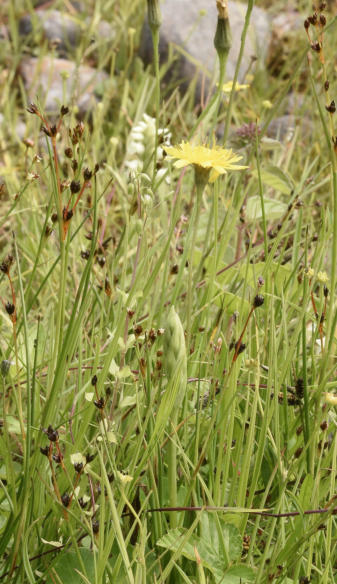


A Busy 2nd Day…
This was a day of some disappointments and some delights. However, where some colonies were lost others replaced them or old beds recovered as part of a natural process. No deliberate damage was caused. The main area of loss was a continuation of the pattern seen last year at the mid-western shore between Gilaroo Bay and Phuilawakhouse Bay east of Lahardaun. Lough Conn lower western shore. This area was fully walked and most of it was bare of Spiranthes romanzoffiana plants. Some clearing of dense onshore bushes (mainly Alder) in the area of Victoria Bay has proved beneficial to the species as they are now colonising the shallow pools left where the trees were pulled up. 46 specimens were recorded here as compared with under 10 last year. These specimens were looking very healthy as the pools still retained some water whereas many other locations were bone dry with very low water levels and orchids could have been exposed to dessication. BUT see an enhancement in numbers on Day 6 later on!Massbrook Shore.
This shore (shown above) had pockets with good numbers of Spiranthes last year but were even then under pressure. On close examination of the image above the whole Spiranthes habitat can be seen. In 2021 the pockets of low shore vegetation could be seen between the lake and the dense vegetation at the back of the shore. Last year some specimens were struggling to survive in old haunts under the Bog Myrtle, Willows and Alders. The shore has also rapidly changed from fine grassy pebbles to larger boulders and bare shore with larger elements exposed by winter storms — very unsuitable conditions for establishing new plants and also probably severe enough to remove older plants. The gently curving beach at the top of this image had good numbers of orchids in the past, particularly in the grassy indented area in between bushes. This area had traditionally been a good area to survey for regular if not numerous specimens. This year there were none!Upper Massbrook Shore.
This shore always had larger bushes and flat ‘grassy’ area which occasionally supported good large specimens — an indication, perhaps, that these were large well established plants. The view takes over from the Image (LEFT) and covers very similar habitat as far as Massbrook Point. The well spaced bushes and the lush growth of grasses supported recognisable clusters. Spiranthes romanzoffiana can produce large clusters of flowering spikes by producing lateral buds close to the soil surface which go on to develop into other specimens. The normal age of such groups in Mayo can be up to 5 years as far as we know. Groups can be easily recognised by their number and shape and ground features; it is very hard to recognise individual small specimens which may be emerging from seed for the first time. None of these groups now exist on this western shore. It is evident from the removal of suitable soil and the appearance of little cliffs where formerly there were plants. The end of this shore is marked by two shallow Points in the middle of the image. After crossing a very small stream (big in Autumn!) there has been an area of large boulders with an onshore population of Hare Bells thriving in among an area of large rounded cobbles with stunted trees (inculding Pine) and little other cover. The boulders may have come from onshore gravel locations? On the shore between these points a small colony was established some distance from the water level; these have now died out as the ground was probably too unstable and without sufficient nourishment for them to survive.… beyond Massbrook Point.
After this point we have very few recorded Spiranthes specimens. The ground is very unsuitable as the trees are larger and very impenetrable. It is unusual to be able to walk along some of this shore. The view (Below) looks back towards the Nephin beg range. This year was the first year in which it was possible to traverse the whole length of this shore; no Spiranthes were found. After passing the rugged Maasbrook Point the shore heads Northwest and the rocky and tree-lined shore is mostly mature Alders bordering a Bog up as far as Victoria Bay with large areas of flat lake deposited grassland.Habitat erosion and recovery.
The shore approaching the stream at the first small point is shown (RIGHT). This is the area which caused us to postulate a ‘wind-blown theory’ of seed distribution from America. On this beach, and others, a regular dotting of new emerging plants can sometimes be seen if the shore is stable and the ‘seed zone’ and seed bed condition can be adequate in terms of fine mix of soil, silt and fungal agents that support the Spiranthes root as it develops underground for a number of years.. The pattern of plants clearly represents a time some years past (exact life times not known) when seeds met ideal conditions here, put down roots, and emerged together some years later. This happened about 5 years ago; it is an unusual event considering the many factors needed to bring it about. The numbers on this shore have since dwindled and now are absent. RIGHT The brown soft path is the location where the string of seedlings emerged; the lake level would be represented by the edge of grasses etc. colonising the shore. The rough shore pebbles indicate some wave action but not too violent. The shore is now often flooded well into the bushes on the Left of the picture.Grass, Herbs, vegetation… Orchids.
In several of these images you will see a sprinkling of green and yellowish vegetation, often around rough ground with many boulders. The shore (Above) is an example but one with many overhanging higher bushes and trees — many of which are dipping in the water for most of the year. L. Conn (and L. Cullin) both have large variations in water level; this years long Summer drought has lead to one of the lowest water levels we have seen. The picture (ABOVE and far RIGHT) show this shore, largely barren because of flooding and the overhanging trees. But these shores can quickly recover. Bruss often collects in lines along the shore — reflective of the way Spiranthes does. This powdery brown material is composed of ground up twigs, leaves, fine silt, fungus’s and decaying moss. Of course, this is easily washed away but given time to settle various herbs and grasses can colonise the ‘leaf mould’ and set down roots into the coarser sand and gravel below. This way they quickly anchor and start to be somewhat immune to lighter waves. This turns the shore into ideal seeding beds (barring storms!) for some years in the case of Spiranthes
Day 2: 31st July
Total Seen today… 183
Spiranthes search… 2022 contd.


Day 2: Zone
Nos. Prev.Yr Habitat
Next…
Victoria Bay L. Conn1
46
+
good
Levally
2
76
20
overgrown
Gilaroo
3
1
-
Cloghans
4
44
26
good
Sandy Bay
5
6
many
early
check later
SndBay Point
6
10
good
karst shore
Daily Summary Chart 2
Woodland plants:
Under the Forest edge spectacular clumps of Royal Fern ( Osmunda regalis) are spreading under the shelter belt of Willows, Alders etc and is a very majestic plant but can take over habitats very quickly.Collection of S. romanzoffiana from this shore
First specimens found after a long hard walk!!!
Specimen growing in Victoria Bay levels
In among small woodland edge.
2 specimens near Sawmill Point

Day 3: 8th August
Spiranthes search… 2022 contd. Inishlee… North West shore of L. Conn

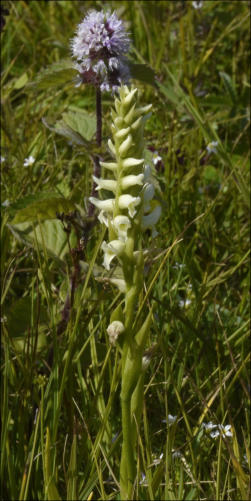


Brilliant weather and brilliant orchids?
Another brilliant day in Ireland exploring the amazing occurrence of Spiranthes romanzoffiana around L. Conn in Co Mayo. Area surveyed today was in the NE of L. Conn between Wherrew (Water Works) and Cappananaglogh just south of Inishlee Island. Today was an early start and an early finish because of the weather but some remarkable Orchids and orchid colonies were seen. Some conservation issues arose with 100+ specimens of this protected species being destroyed soon after emerging in the next zone of Alder scrub. i.e one zone was grazed; the other was not. Owners should exclude livestock and be compensated for loss of grazing. In previous reports all records, habitat reviews and conservation comments, were positive. Unfortunately, this time, some significant impacts on the survival of Spiranthes romanzoffiana in this area has been noted…Weather, Habitats and Species loss…
Observations have been delayed for 8 days to allow specimens and colonies to emerge and flower. The first plants observed were on the 27th July in Lough Cullin; that is late for this area with specimens often emerging in early July. We wonder why? It is possible water level at orchid beds played a role with many colonies located in areas that were exposed to drying out early, particularly the NE corner of L. Cullin with its large area of exposed sand and its collection of Car Parks with wide tracts of shallow water. Exposure to arid and cold conditions in June/early July could have delayed Spiranthes starting to grow. Despite the present hot weather, we did have many cold nights in early July and frosty nights up to end of June. The delay in observations did produce dramatic results — the images surrounding this report of many full large flowers. Spiranthes romanzoffiana is a very sturdy species and able to tolerate much adverse weather and damage both to the plants and their habitats. Loss of Habitat: We reluctantly have to record significant loss of plants in this area due to farming practice along this shore. We all believe in the need for food production and family farms and would hope to see, in the short term, a means of support that will enable Farmers on the east side of L. Conn to set aside land specifically for the conservation of Irish Lady’s Tresses — to give them their glamour name?Today’s Spiranthes romanzoffiana…
LEFT: A lovely group of 3 closely entwined flowers from the shore facing Inishlee Island north of the connection to the mainland. All along this shore there is a grassy border above the stone and below the Alder zone with dense bushes of 1 to 2 metres in height. The lakeside edge of this dense young ‘forest’ is an ideal location for this Orchid RIGHT Another specimen from further down and near the grassy margin of the habitat. The shoreline Mint clearly identifies the borderline habitat and is dominant along with other shore species like Lesser Spearwort, Marsh Pennywort, Self Heal, Eyebright and the gorgeous Grass of Parnassus. Below RIGHT A possible early stage in the development of the ‘frilly’ variant of Irish Lady’s Tresses which now seems to be a speciality of L. Cullin, though this photograph is from Lough Conn BELOW: A developing plant with a loose flower cluster. Flower are emerging at each leaf node…Listing different Environmental Ambitions.
1. Ireland does need to meet its increasing economic pressures. 2. People need to provide for their relatives and loved ones. 3. Widely sourced Income meets all our needs. 4. Social, educational, artistic workers enhance our lifestyle. 5. Farmers are entitled to proper recognition for income coming from land, or labour, or other sources. 6. Rural Ireland is an ideal retreat for resting and relaxing. 7. Land should balance productivity with conservation. 8. Agriculture inputs are getting ever more expensive. 9. Can natural resources enrich the soil at lower cost? 10. Small fields are more secure, attractive and safer from erosion. 11. Trees, clover and many other plants add Nitrogen to the soil. 12. Protecting Natural land merits reward to the minder (ACRES) 13. Much more research must go into native farm nutrients. 14. Leisure walkers need to appreciate where they are walking. 15. Outdoor activities that cause no harm must get support. 16. ‘Unpaid natural restoration work’ needs to be paid for! It’s a long list but every day there are more and more solutions being advocated and more and more ways of saving input costs and using traditional means to maintain soil fertility. We should all agree a One Country policy for all that live here.



An ideal Habitat for Spiranthes…
Why worry about one flower? Perhaps because it is a symptom of our country being wholesome and diverse. If we lose variety in our plants and wildlife we are on the way to a ‘dustbowl country’. At the bottom of this Day 3 account we have added some more views of beautiful plants and stunning countryside. It seems like we are blessed! Where else would you find such a wealth of landscape and interesting wildlife — with one particular plant focussing our attention on making their habitat and their survival a token of our own very survival. Environmental protection and economic survival are very much part of the future? Most of the images are from the Wherrew to the south of Inishlee — a very pleasant shoreline walk. On the mainland shore adjoining the Inishlee causeway a large number of delightful orchids were found in open grassland, then areas with occasional Alder trees, to dense Alder plantation all with numerous specimens of Spiranthes romanzoffiana underneath! It is all just beautiful, the landscape, rare plants, a Summer breeze, making everything just perfect? Interestingly Alders are one of the most efficient ways of adding Nitrogen to poor soil or silt. They can grow here because of root nodules that manufacture their own Nitrogen fertiliser. There are many other plants that do similar work turning parched land into richer land at no cost. The presence of Spiranthes shows all is well? Sadly, further south this sweet order is sundered by the sudden loss of Spiranthes. Cattle need their food and are often released onto the shore in Summer. They seem to love the sweetness of the Irish Lady’s Tresses and can quickly seek out and destroy a colony,Anyone who knows these shores…
will appreciate the order and beauty of the place and not wish to alter any of it, its Natural History, its folklore and appreciation for tradition and memory of older ways. We need to protect our water from blooms and our shores from loss of biodiversity and our agricultural land from unsustainable and irreversible enrichment. Replacing mature varied fields with a monoculture of Rye Grass will reduce the richness of our countryside and simply add to farm costs.
Far LEFT
Spiranthes romanzoffiana benefitting from the rich soil under an Alder Grove.
LEFT
Bare field and a field with small Alders showing many large Spiranthes in full flower.
Middle BELOW
Denser Alder cover further south still supporting many Spiranthes
on a peaceful shore near the causeway to Inishlee
BELOW
Our first ever visit to Inishlee which is normally cut off from the Mainland.
A beautiful place with wide gently sloping Spiranthes beds? But no Spiranthes!
Why; that’s a question for another year. It is, of course, very exposed.
This could have been much larger if a major part of the survey colony had not been grazed!
Total Seen today… 57




















A Sad Story… below
In the our previous days work, we described the unfortunate incidence of cattle on a thriving Orchid bed — clearly an in-
nocent misunderstanding where the needs of Farm Production and our National commitment to Sustaining Biodiversity
led to a situation where many thriving super-rare plants have been eliminated for this year. This can be remedied
through dialogue and more and more accurate information. Perhaps local conservation advice said, as it used to, that
grazing on critical areas like shorelines and areas adjoining where this species grows, could be allowed from the start of
August? This would allow the Spiranthes to flower BUT would not allow them to produce and disseminate seed or to
allow lateral buds (their vegetative means of reproduction) to take place. Of course, they may arise again from their
‘tuber’ assuming this has not been damaged, but after years of not reproducing the species will die out in an area.




Day 4: 10th August
Total Seen today… 29
Spiranthes search… 2022 contd.
Gortnor Abbey, The Lagoon, north coast of L. Conn,
Large Eastern colony of Spiranthes romanzoffiana
Today’s main task was to walk from the Water Plant at Wherrew southwards to Inishlee Island, a small kidney shaped island hard to get to if water is high. Beyond this causeway we know of a very large group of Spiranthes in the low vegetation and scattered Alder trees. This starts north of the Inishlee causeway south to Cappanaglogh and had very large numbers in 2021. The northern part of this back-shore Alder belt is still undisturbed as is the shallow bay and grassland with very few trees. In this area many well spaced single plants grew undisturbed. Moving south of this bay (recognisable on Inland Fisheries Trust Game Angling Guide) the belt of Alders gets steadily thicker and taller with numerous Spiranthes scattered around the stalks of the trees and along open paths through the brush. These are an important resource. Further south there had been even more specimens with some truly tall and magnificent Spiranthes growing tall with long straight (or slightly twisted) flowers as recorded in 2021. These are now gone. Major grazing occurred after we recorded numbers last year and this has just been repeated in 2022 before we had time to record the population. All area in between the Alders had been combed by an industrious herd of cattle. These were not seen but all open grass had been flattened.
A Day of two parts: I. INTRO…
This was the fourth day of our Spiranthes survey of 2022. Things are going well with the help of some friends, but numbers will be down this year for reasons that will become apparent (BELOW). As usual the species was widely dispersed, particularly around Lough Conn, but, to a lesser extent, along Lough Cullin. Spiranthes romanzoffiana will probably have a good long term future here and, as one fellow researcher said… “these must have been here for thousands of years!” Which is interesting, as the popular view is that they are a recent arrival? However we totally agree with our friend’s opinion. Apart from the Ice Age and Climatic Optimum, climatic events in Ireland over that period were not immense or likely to have eradicated the species. They are a native species of North America and, if our theory of seed migration across the Atlantic is correct, the West of Ireland will have a guaranteed ‘Spiranthes’ future. More so than Wales, or other countries more sheltered from the Atlantic. Thus, it is important that transfer of seed occurs in the upper atmosphere from North America, that it falls as rain at its first point of contact on the European side of the Atlantic. (That means the west coast of Ireland, and the north of Scotland). That is the philosophy behind the rings of Spiranthes in the mud holes, and parallel smooth curves of seedlings along curved shores. The pictures on the RIGHT show one of the three habitats we visited today — Longford Point and St. Patrick’s Point. Both of these areas have shoreline plants emerging, or emerging further back along the shore where seed has settled when there was higher water level in the lake. Apart from onshore grazing (which ideally should be limited in Lough Conn) the plants here are fairly well protected. All the plants (pictured BELOW) are from this area. This is the good News story; unfortunately the second part of this report is less benign, and will be elaborated in Part 2 BELOW.
RIGHT
South facing shore of St.
Patrick’s Point, looking back
towards the north shore and
Gortnor Abbey. 18 Spiranthes
were found in the grassy
areas
The shoreline shown was
very gently sloping, with a
good cover of short
vegetation and many small
Myrtle bushes and Alders. At
the back of the shore were
taller trees, mostly Alder.
St. Patrick’s Point
St. Patrick is Ireland’s patron Saint. It is also the name of this promontory that juts out into Tolans Bay where all our study focussed today LEFT: 2 champion plants (one a bud) flowering close to one another under some tall Alder ‘trees’ which form a dense border along the North shore of St. Patrick’s Point right at the top of the Lake. This is effective in sheltering orchids from Winter storms. This group of 2 reflects this species’ ability to produce lateral buds. Both stems are now flowering stems that have arisen from the base of a parent stem and may form a yet larger flowering group. See Below for a large 3 flowered cluster. This may survive for a 3 - 5 year period. We have never seen more than 4 flowering spikes in one clusterA Day of two parts: II A PROBLEM outlined… damage to protected plants and habitats
As you can see from Part 1 another shore has been investigated for the presence of this wonderful/mysterious Irish/American orchid. We publish so many pictures to share with people from home and abroad. As there is much interest in this unique part of Ireland’s biodiversity. Most of our work is thoroughly enjoyable and we never tire of finding new specimens in new places; alas, such new finds are becoming less common around L. Conn as we get to know the place so well. We know where these flowers have disappeared for natural (weather) reasons and we know where to expect new arrivals (a suitable habitat). Most of the new sites, if not all, are assumed to be populated by the wind and water and, over many years research, we know where the soft sand and sheltering grasses and bushes are to be found to welcome and protect seeds and developing underground roots until new S. romanzoffiana — emerge as if by magic! That is the exploration part of our work. But a sad part is where we find these protected flowers damaged and destroyed. A very sad part is where this destruction seems to have been deliberate and where we or State Agencies seem powerless to protect this species and its habitat, protected by Flora Protection orders. Not many species are so protected and we wish that this protection could be afforded willingly or as part of agricultural funding grants. The story below started this time last year on our last visit to The Lagoon — the area analysed BELOW. We did, at that time in 2021, notify the local NPWS (National Parks and Wildlife Service) and have received very quick response where it is easy. But for more difficult situations, where an offence under the Wildlife Act has clearly occurred, it is more difficult to simply rectify the situation. In such cases much information and evidence needs to be teased out. So far we have not got any response to our 2021 report of damage to Spiranthes romanzoffiana.
1.
This shows the site where Spiranthes were destroyed in 2021. The land below
the green ‘lawn’ and the foreshore appears unregistered. The building in the
background has been blurred but the broad area of clearance from the
house down towards the lake can be clearly seen. We know no reason for the
landscaping?
2.
This is a close up of the
site alongside the west
side of the property
where there were pools.
As you can see, the
alder trees and shrubs
are surviving on the left,
but the centre part of
the field has been
cleared and flattened.
3. BELOW
This shows the flattened area
on the east side of the
approach to the house from the
lakeshore. All the Alders, other
trees and vegetation removed,
are piled up on the eastern
border of the property making
two habitats; one flat and arid,
and the other tumbled and
overgrown — both no longer of
use for Spiranthes. We had
hoped that the nature of the
work done here might have
allowed many of the Spiranthes
to survive, but, with the present
weather, and no barriers to the
water flowing in and out, the
area has drained and dried out.
4.
The top of Tolans Bay, at the north shore of Lough Conn, in the middle distance you
can see a small channel, which was the main entrance and exit of water at high
water levels. The area in the front is now bare sand where a raised barrier, which
was very useful in retaining water in the lagoon, has been removed. This allowed
drying out of the site but also allowed flood water to enter and further erode the
damaged habitat.
5. BELOW
Another wider image showing the complete elimination of the raised
bank and trees on it allowing a broader area for Winter storm damage.
7. BELOW
This shows a barren pond where Spiranthes is struggling to survive. The reason
there are so few this year is partly because of the weather, but also because all
the channels have been opened up, and any pools that were surrounded with
plants have now drained their water into the lake. A few orchids have survived
in the shelter of the Alders at the edge of the area.
8.
Picture 8 shows a
bigger area of the
pond, a single
Spiranthes, and
smooth grassy land
going up as far as
the house. This land
normally hasn't
been smooth and
grassy, typically it
would have ponds
scattered all over
the place, little
streams, banks and
mostly Alder trees
around the edges.
So the habitat here
has, once again,
been made
unsuitable for large
numbers of
Spiranthes — but it
could well be
restored.
9. BELOW
Between the dry pond and the house is partly neighbouring land but the less
crowded Alders and the piled up waste material are part of the site. Adjoining it
to the Right is an undisturbed area of regular medium sized Alder bushes also
mainly without Spiranthes present. This site remains very much the way we have
known it for the past 5 years and it was never a very important site for
Spiranthes romanzoffiana. The making of ‘The Lagoon’ was areas of grass, areas
of Alder, ponds and streams running gently between these, mainly on flat
ground, providing a variety of niches in the unaltered site with plenty of moisture
and shelter for the Spiranthes.
10. BELOW
This is an overall view showing half of the cleared area in front of the
building. Not much more to say except that none of the former bushes are
visible and… we only managed to record one Spiranthes in this location.
OVERVIEW:
This beautiful mountain rules over all this upheaval, and we
hope that the Gods of Nephin might someday come and
recreate the wonderland that we had here for many years! It
looks as if previous efforts may have been made to reduce the
height of the Alders, or to cut the Alders, but never has so much
clearing of the land been undertaken, nor so much soil removed
which has led to the almost-complete drainage of the site and the
loss of habitat.
The pictures on the Right and Below show examples of damage
(like last year) to a protected Plant and the protected Habitat. All
these Images are from this day but the status of The Lagoon is
very much as it was last year… damaged fundamentally,
drainage patterns broken, orchid bearing soil strata scraped off
the surface, protective trees and lakeside defensive structures
like banks, narrow channels and established Alder trees altered…
more or less the same as reported to the NPWS at this time last
year
These all need to be replaced… but HOW?
GOODWILL:
This research is conducted by 2 retired Biologists reflecting our love for nature and our enjoyment of diversity and wonderful countryside.
Our intent, particularly in the latter part of this days work (the Grey Zone) is not to cause friction but, having seen rare plants flourishing in the former habitat we would just like an outstanding micro habitat, like The Lagoon,
respected and repaired.
The pattern of clearing ground from the House (Fig 1.) to Lough Conn’s north shore seems to have occurred before. We would not re-publish this plea if previous information sent to the NPWS had been responded to, or is
being acted upon? Perhaps it has; these things take time. We would love to know as over many years we have garnered information and reported on large areas of wilderness with their wild and rare plant and animal
species.
We do not know who undertook this landscaping, who informed them of its ‘merits’ and was it just another unfortunate mistake!
BUT, it needs to be put right and, after this days visit with little numbers of Spiranthes romanzoffiana emerging, we think that that may be harder to do than first suggested. i.e, levels of soil important to the overwintering
orchids has in many locations been scraped away.
RIGHT
This image is a close-up of
the above image. The main
flowering area is in the
grass and Alder and Myrtle
covered shoreline back
towards the higher trees.
The small Alder bushes are
well spaced out. These
provide some protection for
Spiranthes, from the
elements and grazers.

6.
The widened entrance to the lagoon is shown here, also the flattened tops of
light green grasses which were all covered in Alders two years ago. These
helped to bind the soil, gather Spiranthes at the base, and prevent more
erosion of a very good habitat.



Damage depicted in Images: (2022)
Beauty depicted in an Image: (2022)
Spiranthes romanzoffiana is a truly amazing plant. Even its name is
romantic. Named after a Governor in the far east of Russia in
times of the Tsar, who ordered a crew and ship to sea to explore
the New World of Kamchatka and beyond.
We dropped this image in of a ‘family of 3’ recently found and
recorded at St. Patricks’ Point nearby. They have amazing ability to
travel around the World and to recover when hurt or damaged.
An ‘American species’, their only hold in the Old World is here in
Ireland and in Scotland. Their survival in Ireland is guaranteed and
protected and watched over by a loyal and increasing band of
admirers.
Aren’t we so lucky… Let us hope that modern Russia will soon
return to peaceful ways and help us all protect a fragile and
beautiful world.
LEFT:
Large specimens can be very dramatic. To become
large they need shelter often from small trees where
they can be protected from grazing. However, cattle
are adept at rooting them out… they can they smell
the plants or seek its roots! This is a mature specimen
with just one stem. But its height and strong flower
suggest it has an established widened root
underground.
BELOW
From the south side side of St. Patricks, this specimen
was well sheltered close to deep water and growing in
lush undergrowth. Catsear and Eyebright being
salient herbs where the Spiranthes grows
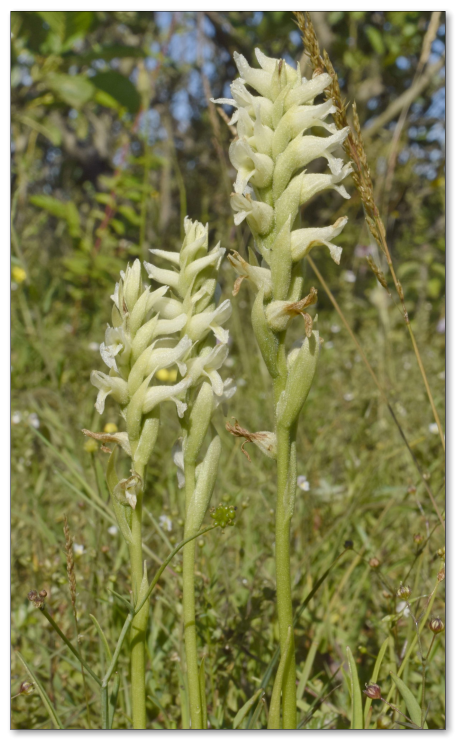
In a desire to publish current information we are uploading this report as is and will try and update soon. (E&OEs)
The placement of these Images reflects where problems with landscaping the site occurred…
Day 5a: 14th August
Spiranthes search… 2022 contd.
Addition to Spiranthes Count for 27th July

Welcome…
Very happy to have two more volunteers join our Spiranthes recording team. This is a 100% increase in manpower! Sarah and Richard Rainbow from West Yorkshire with strong Irish connections are, like us, keen part time Botanists. With connections around Lough Allen in Co. Leitrim they were both anxious to see if the formerly good records from there in the 2010’s were still holding up. They eventually got through to us via our old web site, www.loughallenbasin.com and we provided them with certain old information but not relating to the present situation (as we are out of touch there). After very dedicated searching in many areas of L. Allen they managed to find just 2 specimens. When they found out what we were doing in Lough Conn/Cullin they immediately agreed to help. We were conscious that our first survey of the season, Drummin Bay, its adjoining sandy Car Parks, and a large area of reeds and invasive vegetation, was woefully inadequate and needed to be repeated. We suggested they join us and that was quickly arranged and our team of 4 quickly went to work. The RESULT is shown on RIGHT: Drummin Strand is part of a larger zone including 3 Car Parks with Beaches and some isolated records further South, All these areas have been checked and there is no significant change in numbers so the Counts for these areas remains the same. As expected, the extra help brought a good increase in numbers recorded on the 14th of August. The 2 women had excellent eyes and kept the recorder busy adding the data. There are now 101 records from this part of the area. This is highly satisfying combined with other numbers on the Car Parks and, especially, Car Park 1 with its Nursery of young specimens that seem to survive from year to year with sometimes heavy footfall. The Process: • Records for 27th July and 14th August were given different symbols. This led to a count of 149. • All records for 14th August were kept — as they had just been recorded. • Many extra records were valid from 27th July, being sufficiently far away from other specimens. • Many old records too close to new records were regarded as duplicates and eliminated. This led to a final verifiable count of 101. Many thanks to Richard and Sarah… the best of company.


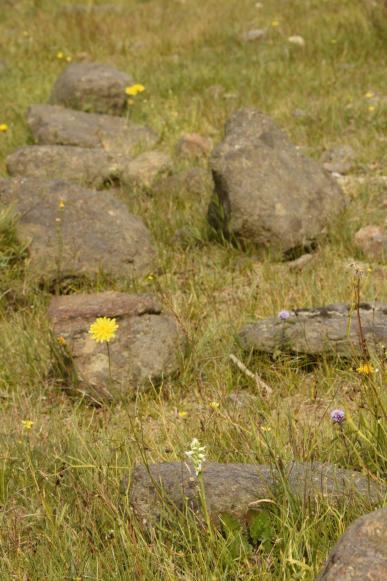


Sandy Bay
This is another site that was already visited, but it was early and hot then and orchids were scarce so a count was not made then Today turned out to be a good day for the area Sandy Bay is an interesting place. A beautiful sandy shore embracing a small Cranóg type Island is a popular swimming area. Its east shore has gently dipping sharp edged limestone pavement which should be good for species such as the Dense Flowered Orchid — though likely to be flooded at their time of flowering. We have never found either of the “Irish Orchids” here. But on the western side of the bay more karstic type limestone forms a sharp shallow tip to the headland. 10 Spiranthes have been recorded here… good numbers for such a hostile place and only a little fewer than previous years. LEFT: Behind the Beach is a very rich bog partly sand and very much peat which can be extremely deep and soft in normal conditions. The specimen shown (LEFT) has been here for 4 years. Normally it is in a comfortable position on the waters edge with a protective pool in front of it. This year all is dry, even the soil is cracked and raised up so that one would wonder how this plant survives. But all other specimens seen on this day were also strong and healthy. Some specimens were missing from the back of the beach and the long meandering channels bringing the lake into the marsh, but no dried out Spiranthes were seen… perhaps another virtue of this species. It likes both arid and wet places?Corryosla Bay
A small inlet about 1.5km north of Pontoon. A sandy beach with many thickets and abundant Great Burnet (though not so common this year) marks the entrance with a sprinkling of Spiranthes around the east side of the bay. An attractive, biodiverse location with 8 Spiranthes, some well established (i.e. pairs) — some very fine specimens as shown (BELOW). Two interesting lakes with a large stream (river) drain into Corryosla from the opposite side of the road. The situation is a bit like Levally Lough (which was spectacular this year). Attiappleton Lough is a beautiful lake shrouded by hills but with very little grassland or sandy bays adjoining it so it can be ruled out for Spiranthes as a source of seeds downstream! we haven’t managed to survey it yet as the area seems very private. It could be the source of further Sprianthes?
Viability of Site at Corrysola for S.
romanzoffiana .
Whereas the entrance to the site is now
overgrown and turning into a small mixed
woodland, the grassy shore on the east of
the bay is the only source of specimens
now. This has always been a favourite
location but used also occur nearer to the
entrance from the R315 before this became
overgrown. Warming conditions and
exposing of shallow sandy shores provides
an attractive niche for specimens around
the grassy island shown ABOVE. Parking is
readily available on a bend to the north and
then a 100m walk south along the road
until a lane appears on left.
Site at Corryosla
Naming of some of these sites is tricky and many of the
names on the Game Angling Guide are not in everyday use.
Park at a lay by at a lane and walk south to a concealed
entrance to the lake.
When you leave the road, find a way through the gravelly tree
covered shore and across a shallow bay. This bay can be
muddy and quite deep but on this visit it was just ankle high
and it brings you easily to a large flat sandbank with the lake
to your left and a bank of small bushes lining the eastern
shore. (Image Far LEFT)
S. romanzoffiana occurs in both locations, being prominent
and visible from some distance on the very low grass cover
with some small boulders being their only shelter (LEFT).
Specimens were doing well here despite the very hot weather
and exposure. Dew at night keeping them moist?
RIGHT
This was one of several individual specimens or pairs
found at north Knockmore near to the shelter of grasses
and low bushes in the sandy/rocky peninsula north of the
marked channel. Bigger specimens like these seemed to
occur close to shelter.
Knockmore north
Knockmore is an interesting area where Spiranthes romanzoffiana has been recorded over a long period. It consists of a large flat wet meadow on the north side of the Bay where orchids used to occur. They are now marginalised to the north edge of the bay and the western tip where there is a marked boat channel providing an exit to L. Conn. This area is not grazed and Spiranthes was present in good numbers. With 6 earlier recorded on the south side of the bay today’s count brings the total to 21.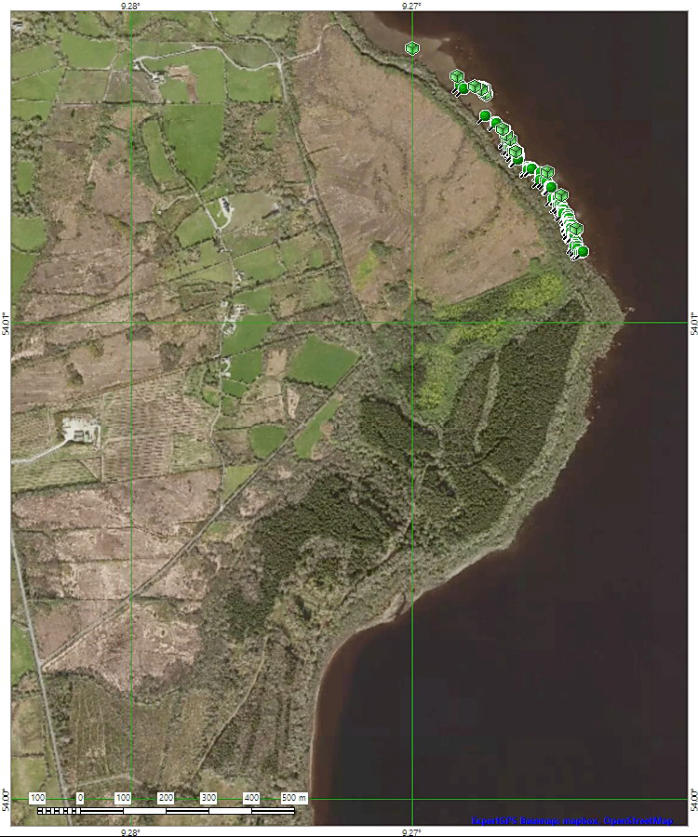
Errew peninsula/Monastery, Mid-West L. Conn:





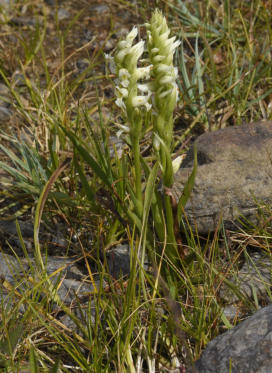

Summer re-count Victoria Bay, L. Conn
This re-count was undertaken today using 2 personnel to cover the ground from the top of Satellite view (ABOVE) to the the point (Massbrook Point) conveniently outlined by the line of Latitude in the middle of this picture. All data is from 17th August 2022. It’s a wide shore so we worked some distance apart while still taking care to avoid duplicates. The ‘green cubes’ represent areas of possible duplication. But the distance between neighbouring records has been checked and all green cube symbols are valid. We have overlaid the earlier count (not in this image) and the records are impossible to differentiate. Consequently, the earlier data has not been shown above but numbers have increased from 44 to 115 — a highly satisfying level of new specimens over 19 days. N.B. We hope at a later stage to upload earlier records on the shore south of Massbrook Point, showing a very similar density of specimens. It’s like someone turned off the lights at one place and turned them on further north? Actually we think it is entirely down to weather, land management and alteration of the two shores by natural forces (south shore) and Man’s intervention at the north shore, this time being very beneficial to this rare and specialised species. Hopefully the present shore, and the lack of grazing, can be maintained! Shore reclamation is already taking place in this calm settled weather. Water is at its lowest level; parallel bands of deposition are taking place. Bare sand beds close to the water; sand and bruss with some grass seeding after that; larger band with established grass/herbs; finally breaking down vegetable material (leaves, buds, tiny branches, dry and decomposing moss. This is all very promising but we have a Winter to face yet!Two specimens
from a
recovering
population:
We were both very pleased to see such a large increase in specimens over a few weeks at Victoria Bay. Many of the August records could be recognised and are included in this return.
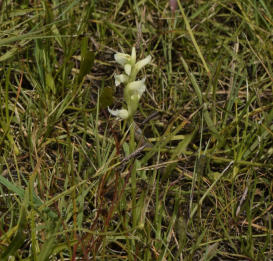
ABOVE: There is a slight bank separating the grassy area from the reed
bed which markis an average water level.

© Shelagh Delphyne
We have some keen Naturalists on the Errew Peninsula
who keep a watch out for Spiranthes around their
shores. Thanks to Shelagh for this lovely image taken
at the edge of a small pool just south of the road at
Gallaghers Bay. Dry weather had, unfortunately led to
Swam Mussels dying in this now isolated inlet.
The area around Errew Monastery has had good
numbers in the past and the shoreline is still attractive
to the species but… Cattle like it too.
When surveyed the shore west of the monastery
showed several pairs, always a good sign of mature
plants. However, if they are persistently damaged they
will eventually cease to reproduce vegetatively. Still,
there is always the possibility of seed coming from
America and settling around the peninsula in Autumn
rains.
Strong healthy Plants:
A quick search almost as far as the Point revealed mainly tall and mature specimens in couples and as single plants. Many Spiranthes used to be recorded along the south shore of Errew Bay but growing intensification of farming has reduced the numbers surviving. We would hope that future Biodiversity Measures might sometime get established and it will be to everyone’s advantage that local landowners can get some benefit from having this unique species growing in glorious abundance around these shores. We have heard talks about an ACRES scheme planned to formalise protection for rare plants and animals and all biodiversity. The Monastery perhaps could be a focus for this almost miraculous plant — that disappears and reappears so suddenly! We are now winding down our coverage of Spiranthes romanzoffiana in and around L. Cullin and L. Conn. Any local knowledge or records would be very welcome. Remember they are white, spiral shaped, will be wilting to brown from the lower flowers upwards — as shown in Image on RIGHT!DAY 6

Day 6: 17th August
Total Seen today… 29
Spiranthes search… 2022 contd.
Corryosla, Victoria Bay, Errew
5b: The rest of Day 5
ABOVE: 2 separate images of a set of twins
(mature?) and a single new specimen arising!
Full Surveys of Sandy Bay and Knockmore Bay, both east Lough Conn

Day 2: Zone
Nos. Prev.Yr Habitat
Next…
Wherrew
1
53
-
good
Cappanaglogh 2
4
-
overgrown
Inishlee Isl.
3
0
Low water but good Site

Day 4: Zone
Nos. Prev.Yr Habitat
Next…
Gortnor
1
4
+
good
St. Patricks Pt
2
21
-
good/no grazing
The Lagoon
3
7
-
remains damaged
Daily Summary Chart 4
Daily Summary Chart 3

Day 5: Zone
Nos. Prev.Yr Habitat
Next…
Drummin Beach, L. Cullin, second count here this year.
RECOUNT
after a large increase since July…
1
101
57
Excellent
Knockmore
2nd
10
6
Good
Sandy Bay
3rd
16
26
good/extensive
Daily Summary Chart 5a and 5b
Many thanks to all who have offered help this year. We miss European visitors — for
obvious reasons — but hopefully they will feel free to travel in the pursuit of such
worthy past-time and research. It can be addictive.

Day 6: Zone
Nos. Prev.Yr Habitat
Next…
Corryosla
1
8
2
good
Victoria Bay
2
115
-
now perfect?
Errew
3
10
22
over grazed.
Daily Summary Chart 6
NOTE: Total number is for area covered by Map below. All other values for the NE corner of L. Cuillin on Day 1 remain the same: Total Recount below =101

BELOW:
Altogether this shore had 15 specimens and looks like it might have potential for more
depending on the climate in future. It is a very peaceful area with no obvious threats to
survival. The area beyond the markers, looking South, seems ideal for this species but has not
been surveyed yet as it is difficult to access both from the North and the South

Victoria Bay
Massbrook
Point
Massbrook
shore
Reproductive Issues with Spiranthes romanzoffiana
1. This orchid produces seed towards the end of the flowering season, mainly in September in Ireland. 2. Frequently our climate changes towards the end of August and flooding occurs on L Cullin/Conn 3. Flooding will destroy fresh seed after a while. 4. All orchids have means of reproducing vegetatively whereby a shoot/shoots (i.e lateral bud) emerges at ground level. These can go on to produce future flowering stems irrespective of flooding or other weather conditions. 5. While seed production is going on this orchid seems to delay lateral bud formation. 6. It is very unusual in Mayo to have an extended Summer (an Indian Summer) but so far 2022 is looking good. If large scale reproductive success occurs this Autumn (Fall) we will be monitoring both forms of reproduction and regeneration in this species, weather permitting. This work will be produced as Study of Spiranthes Reproduction in North West lakes in Ireland This is NOT LINKED yet! This research will be kept separate from this Survey Page (SpiranthesSurvey2022.html) We are winding down that survey but the recording and interpretation of future new plants may last a long or a short time and with so many specimens either producing seed or starting to develop lateral buds for next year. (Seeding if successful will take up to 5 years to be seen.)









Day 7: 26th August
Total Seen today… 56
Spiranthes search… 2022 contd.
Pontoon North, Pontoon South, NW corner L. Cullin, Massbrook
Pontoon North & South 25
We are trying to bring together a series of small sites studied today. 1 Spiranthes was found in a bay adjacent to the road at SE Lough Conn —formerly more plentiful. South of Pontoon Bridge on the east bank (RIGHT) a good colony of 24 Spiranthes were thriving. This is an established group growing on a calm grassy shore below the deep water channel coming from L. Conn.NW corner L. Cullin. 19
A Sandy Parking place looks out to a headland beyond an area of very dry reeds. This leads to a small settlement of 9 Spiranthes, matching a smaller colony last year (2021) on the south side of the peninsula. About 1,2 km south of the old Healy’s Bar site another surprisingly good location was discovered just east of the main road. 10 were found there.Massbrook Shore. 12
Finally the day ended on Massbrook Shore with 12 new records, 11 of these north of the little stream entering the lake as the shore curves eastwards heading towards Massbrook Point. The other specimen was indeed one of the last of the long surviving lost orchids. We missed it — but once we saw it we remembered it from 3 or 4 years ago. The other 11 specimens, some single some pairs, were in the upper part of the shore at the ‘big bulge’. This area had specimens 2 or 3 years ago, both along the shore edge and also in among short sturdy alders lining the shore a bit further inland. These were so obvious today, and all in a line, that we could not believe we had missed them before! A possible theory… Perhaps both records are correct and the 11 midshore specimens had indeed emerged since we last surveyed that shore (31st July). Because of the extra stability, nutrition and humus that the Alders supplied specimens established sturdy roots and were able to survive sveral Winters — whereas the more recently appearing plants at the waters edge in 2021/2020 were completely destroyed and washed away by waves churning up pebbles and boulders. This is not hypothesis; we were there on a stormy day when that shore was being heavily altered by breaking waves and strong backwash. However, we have now re-surveyed the formerly high yielding population along the Massbrook Shore and no small seedling plants have emerged along the waters edge. The bedding material (dead leaves, twigs, dry moss, sand/silt etc.) is now developing a seed bed. Will it last; Spiranthes seeds take years to germinate. Many parts of this shore appear the same as in earlier years; in particular the grassy band between the shrubby Alder/Bog Myrtle zone and the coniferous plantation further up the shore. The lush green grassy strip in this zone held several well spaced Spiranthes. These tended to be fewer in numbers but supporting very tall and luxurious flowers; it would be nice to see more of these before the season ends. ONLY 1 REMAINS!
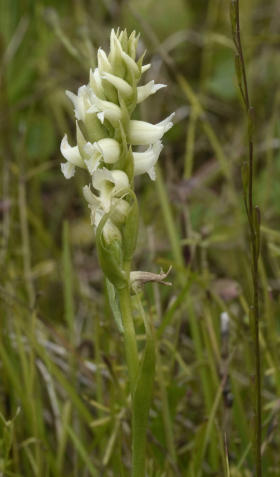
A very fine S. romanzoffiana from the newly emerging
colony at Victoria Bay on the west shore of L. Conn
Today’s repeat visit to this shore was very well justified as
many more specimens had appeared in this lightly cleared
and low lying shore.
Unlike at The Lagoon the removal of large Alders was tidily
done and left only small pools which Spiranthes has now
exploited.
A shy Specimen from Pontoon…
This and 23 other specimens occupied an
undisturbed grassy bank just below the Pontoon
Bridge and on the east shore of the channel.
This is an established colony with little obvious
threats from Man or Nature



Day 7: Zone
Nos. Prev.Yr Habitat
Next…
Pontoon
1
25
28
very good
NW Cullin
2
19
++
exposed
Massbrook
3
12
-
ideal.
Daily Summary Chart 7
NEXT from WildWest
